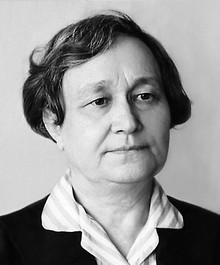Pelageya Polubarinova-Kochina facts for kids
Quick facts for kids
Pelageya Polubarinova-Kochina
|
|
|---|---|
 |
|
| Born | 13 May 1899 Verkhny, Tsarevsky Uyezd, Astrakhan Governorate, Russian Empire (modern Pokrovka, Astrakhan Oblast
|
| Died | 3 July 1999 (aged 100) |
| Nationality | Russian (1899-1917, from 1991) Soviet (1922-1991) |
| Alma mater | Petrograd University |
| Spouse(s) | Nikolai Kochin (m. 1925) |
| Scientific career | |
| Fields | Applied mathematics |
| Institutions | Petrograd University Steklov Institute University of Novosibirsk |
Pelageya Yakovlevna Polubarinova-Kochina (born May 13, 1899 – died July 3, 1999) was an important mathematician from the Soviet Union. She was famous for her work in applied mathematics, especially in understanding how liquids and gases move. This field is called fluid mechanics or hydrodynamics. She also studied the history of mathematics.
Pelageya Polubarinova-Kochina became a special member of the Academy of Sciences of the USSR in 1946. Later, in 1958, she became a full member, known as an academician. This academy is now called the Russian Academy of Sciences.
Contents
Her Early Life and Education
Pelageya was born on May 13, 1899, in the Russian Empire. She was the second youngest of four children. Her father was an accountant, and her mother was a housewife.
She went to a high school for girls in St. Petersburg. After finishing high school, she continued her studies at Petrograd University. This was after the Russian Revolution of 1917.
Her Career and Family
In 1918, Pelageya's father passed away. She then started working at a geophysics laboratory. There, she worked under the guidance of Alexander Friedmann, a well-known scientist.
At the laboratory, she met Nikolai Kochin. They got married in 1925 and later had two daughters. Pelageya and Nikolai both taught at Petrograd University.
In 1934, they moved to Moscow. Nikolai Kochin started teaching at the University of Moscow. Pelageya Polubarinova-Kochina began doing research at the Steklov Institute.
During World War II, Pelageya and her daughters moved to Kazan for safety. Nikolai stayed in Moscow to help with the war efforts. Sadly, he died before the war ended.
After the War and Later Achievements
After World War II, Pelageya continued her work. She edited her husband's lectures and kept teaching applied mathematics. She became a leader in her field.
Later, she became the head of the theoretical mechanics department at the University of Novosibirsk. She also directed the applied hydrodynamics department at the Hydrodynamics Institute.
Pelageya was one of the people who helped start the Siberian Branch of the Russian Academy of Sciences in Novosibirsk. This was a very important scientific center.
She received many awards for her contributions. In 1946, she was given the State Stalin Prize. In 1969, she was honored as a Hero of Socialist Labor. She also received the Order of Friendship of Peoples in 1979.
Pelageya Polubarinova-Kochina lived to be very old. She passed away in 1999, just a few months after her 100th birthday. She even published her last scientific article shortly before she died.
See also
 In Spanish: Pelagueya Polubárinova-Kóchina para niños
In Spanish: Pelagueya Polubárinova-Kóchina para niños

